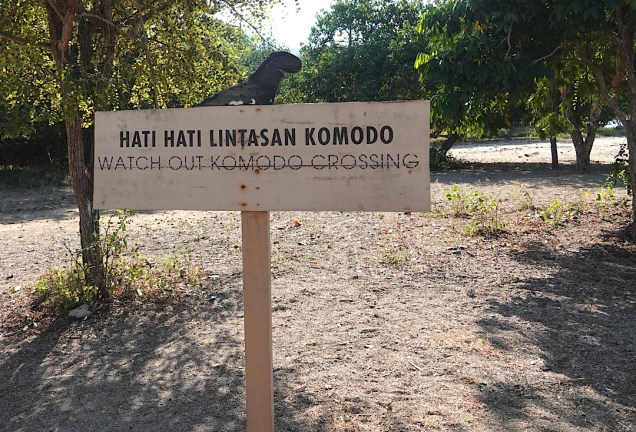 The news was discouraging when we landed on Rinca Island Tuesday afternoon. No one had spotted any Komodo dragons that entire day — nor the day before. I tried to resign myself to the same fate. When you seek rare animals in the wild, it’s not like buying a movie ticket. You’re not guaranteed a show. But we lucked out.
The news was discouraging when we landed on Rinca Island Tuesday afternoon. No one had spotted any Komodo dragons that entire day — nor the day before. I tried to resign myself to the same fate. When you seek rare animals in the wild, it’s not like buying a movie ticket. You’re not guaranteed a show. But we lucked out.
Almost immediately after we paid for our admission to Komodo National Park, the friendly park ranger to whom we were assigned urged us to run — toward a dragon that had just ambled into the entry complex from the nearby forest. She was a female maybe 7 years old, he estimated, and thus maybe only half the size of a full-grown male. Still, no one who saw her could doubt she and her kind are the biggest lizards in the world. If they were any bigger, you’d be looking at a dinosaur.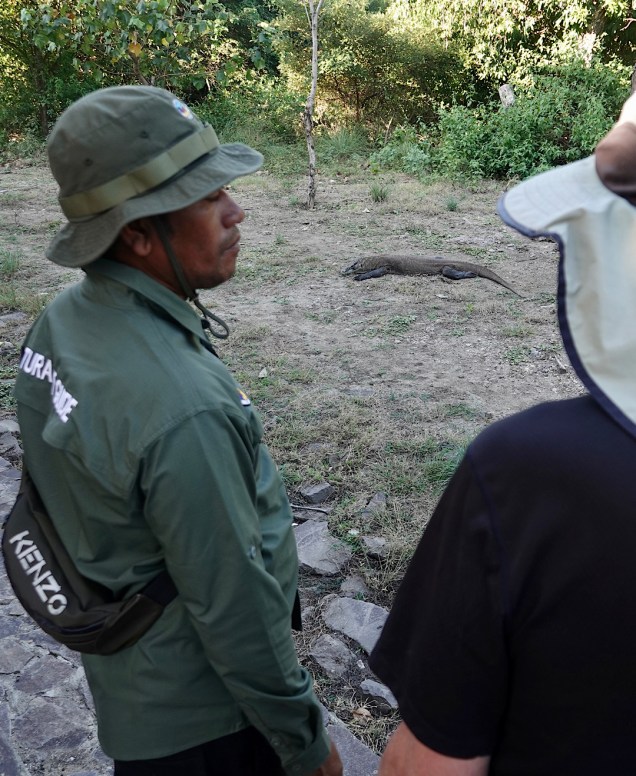

As lethal as her claws appeared to be, they’re not her main weapon. Each Komodo dragon’s jaw holds 60 teeth, and sandwiched among them are glands loaded with toxic venom. A single bite won’t instantly kill a deer or buffalo (or human), but the venom promotes bleeding and dreadful infection to which victims succumb after a few days or even hours. Adding to their charm, the dragons are cannibals, eating each other and even their unwary young. Smarter youngsters hide in trees for several years to avoid being munched.
I’d rank them as the least lovable of the world’s big flashy animals. Nonetheless Steve and I had a blast on our two brief forays into their world. That first afternoon, our ranger, Masakao, led us on a hike into a tangled forest that’s also home to spitting cobras and other venomous snakes. The plant life looked different from what we’d seen in the forests in Bali and Sumatra. That’s because when we had flown east from Bali, we crossed the Wallace Line. Eons ago, the continents of Asia and Australia had broken apart along that conceptual demarcation, and so today the plant and animals on either side of it have different evolutionary origins.
We moved down the dirt path and soon approached a small abandoned building that once housed a power generator. Masakao motioned for us to stop while, armed with a long forked stick, he crept up to the doorway and peered in. Another score! The ranger asked for Steve’s phone and recorded the temporary occupant: a male whose big belly testified to recent consumption of a meaty feast. Now he was digesting in the cool comfort of the man-made shelter.
Another score! The ranger asked for Steve’s phone and recorded the temporary occupant: a male whose big belly testified to recent consumption of a meaty feast. Now he was digesting in the cool comfort of the man-made shelter.
In the course of our ramble, we came across another big male. That one even gave us a look at his fearsome choppers…
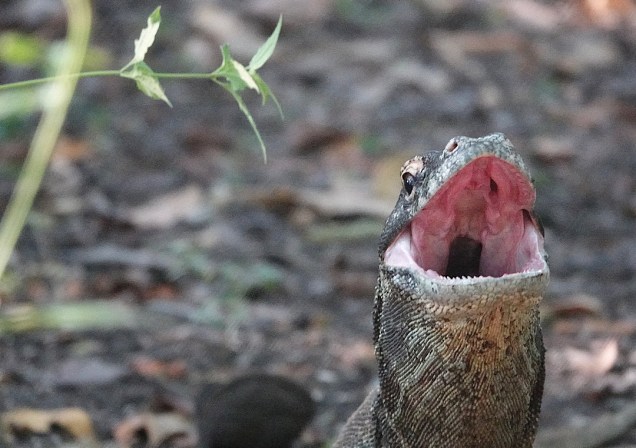
…before crossing the trail and moving into the underbrush, long tongue flicking.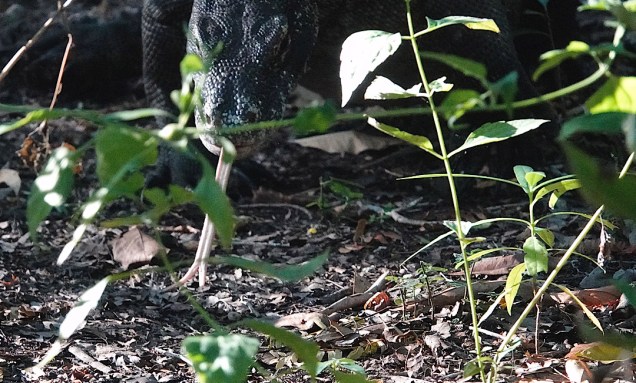
I felt jubilant as we returned to our quarters for the night, a wooden ship of eccentric design that’s common in these waters. To see Komodo dragons you need some kind of a boat. The famous reptiles live almost exclusively on five islands off Flores (a bigger island originally colonized by Portuguese and thus home today to one of Indonesia’s only significant Catholic populations.) You can take a speedboat from Flores out for a frantic, grueling day of dragon-hunting, but most visitors opt for a one- to three-night cruise. Steve’s and mine was a private one, and included the services of a conscientious guide named Robert and four young men who ran the ship and cooked.

It was far from fancy. Here was the single toilet/shower stall shared by the 7 of us: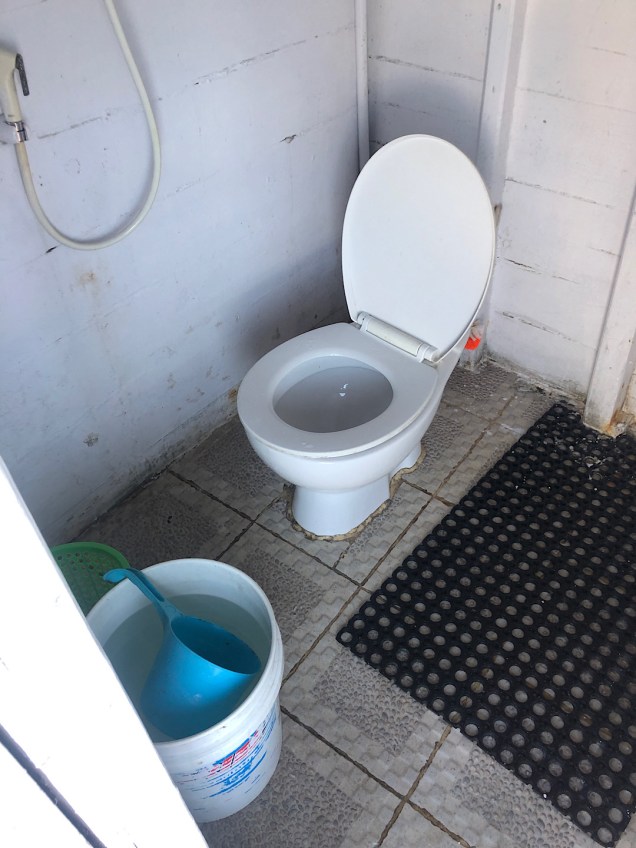

…and the galley where the cook whipped up meals like these:
This lunch included rice (in the covered dish), tofu sautéed in a soy sauce, stewed cabbage and carrots, and squid prepared two ways.
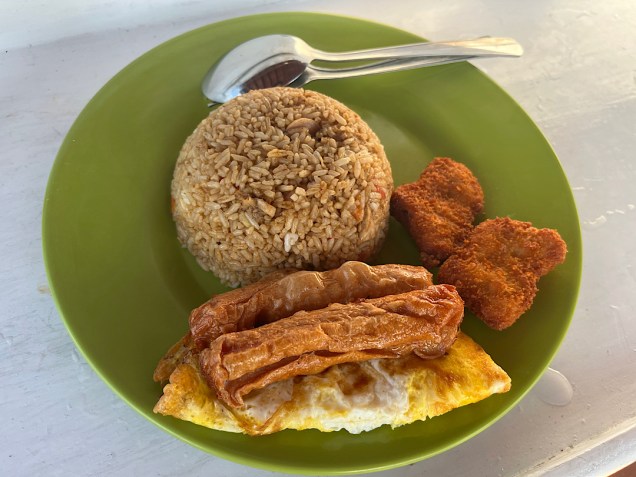 This was breakfast the second morning.
This was breakfast the second morning.
If basic, the food was edible, and it didn’t make us sick. Our cramped cabin also had an AC unit that cut the muggy heat. I kept reminding myself that the sojourn was less grubby than tent-camping in the tropics. Slightly.
The second morning, Robert, Steve, and I left the ship before dawn to join the stream of visitors climbing the 815 steps up tiny Padar Island.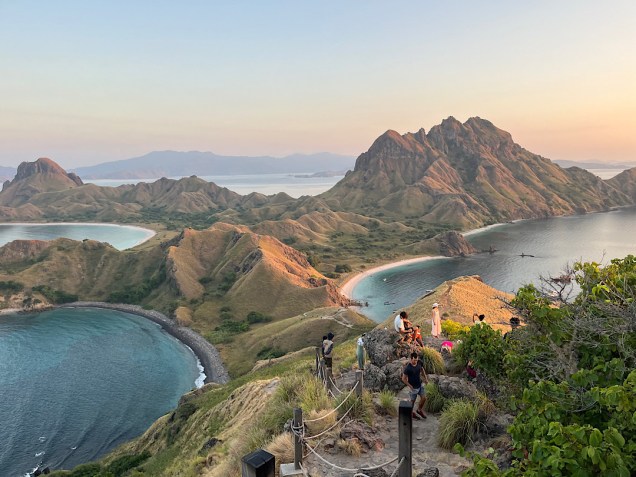 The view from near the top, taking in three different-colored beaches (black, white, and pink) is so famous it’s on Indonesia’s 50,000-rupiah bank note. Indonesian tour groups pressed for time will often choose to visit it and skip the Komodo dragons, according to Robert.
The view from near the top, taking in three different-colored beaches (black, white, and pink) is so famous it’s on Indonesia’s 50,000-rupiah bank note. Indonesian tour groups pressed for time will often choose to visit it and skip the Komodo dragons, according to Robert.
But who would choose a landscape selfie over what we saw later that morning? I can’t imagine.
Once again, luck was with us. We motored to Komodo Island, and on the beach we immediately found a young dragon, risking its life to come down from its tree and hunt for breakfast.
Not far from the juvenile, an alert-looking adult female was identifiable by her head and tail, shorter than than what males are equipped with.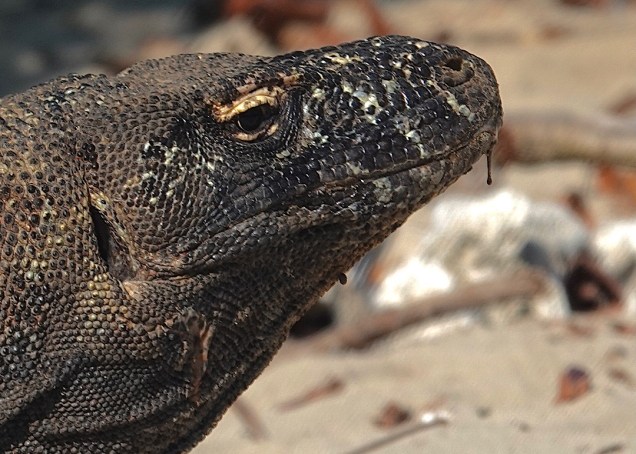 This time our park ranger, Dula, took my iPhone and shot the wonderful video footage I will try to incorporate here. I hope it’s viewable on the blog; part terrifying, part comic, it’s documentary evidence of one of the most unforgettable strolls of my life.
This time our park ranger, Dula, took my iPhone and shot the wonderful video footage I will try to incorporate here. I hope it’s viewable on the blog; part terrifying, part comic, it’s documentary evidence of one of the most unforgettable strolls of my life.
We encountered several more of the dragons during our visit. Then it was time to board the boat again and motor on; reptiles weren’t the only animals on our itinerary. The turquoise waters that surround the dragons’ islands conceal choral reefs and a wondrous community of aquatic life. We didn’t succeed at seeing all of it. The wind blew hard for a few hours on our final morning, whipping up white caps that drove the local manta rays and sea turtles to deeper water. But we did manage to snorkel three times in calm water, and each outing delighted me. The sea was clear and warm, and I felt as close as I will ever get to flight, gliding effortlessly over the landscape of coral and anemones and rocks, in the company of neon-colored fish, many dressed up in astonishing patterns. At times we sailed by rivers of fish; into clouds of them. Once I started to laugh out loud at the concentrated beauty but was quickly reminded that’s not a great idea when you’re breathing through a snorkel.
We didn’t succeed at seeing all of it. The wind blew hard for a few hours on our final morning, whipping up white caps that drove the local manta rays and sea turtles to deeper water. But we did manage to snorkel three times in calm water, and each outing delighted me. The sea was clear and warm, and I felt as close as I will ever get to flight, gliding effortlessly over the landscape of coral and anemones and rocks, in the company of neon-colored fish, many dressed up in astonishing patterns. At times we sailed by rivers of fish; into clouds of them. Once I started to laugh out loud at the concentrated beauty but was quickly reminded that’s not a great idea when you’re breathing through a snorkel.
Our first night on the boat we made one other wildlife stop that caused me exclaim with awe. It was close to sunset when we anchored on the eastern side of a long flat island composed almost exclusively of mangroves. We watched the molten tangerine sliver of sun shrink to a dot and disappear and the color begins to drain from the sky. Several long moments passed, but enough of a glow still remained that I could make out the strange thing that began to occur — a stream of tiny black objects rising out of the mangroves like cinders flowing up from a campfire and dispersing.
We watched the molten tangerine sliver of sun shrink to a dot and disappear and the color begins to drain from the sky. Several long moments passed, but enough of a glow still remained that I could make out the strange thing that began to occur — a stream of tiny black objects rising out of the mangroves like cinders flowing up from a campfire and dispersing. The stream thickened and grew; that’s when I cried out. These were fruit bats, a vast horde of them, ranging out by the millions to hunt insects in the night.
The stream thickened and grew; that’s when I cried out. These were fruit bats, a vast horde of them, ranging out by the millions to hunt insects in the night.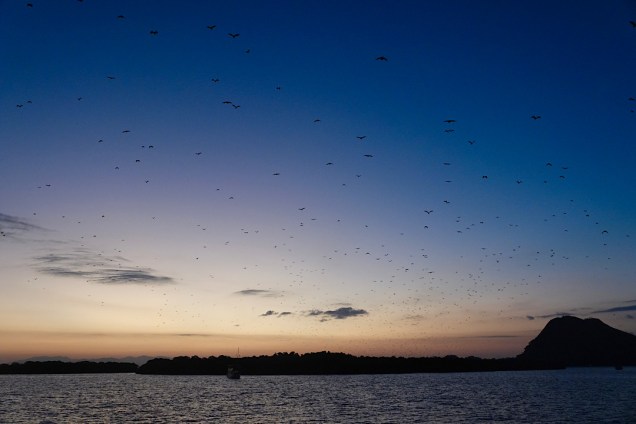
People sometimes call them flying foxes, but as they passed overhead their iconic shape was unmistakable, flapping, gliding, graceful.
More and still more bats continued to pulse out of the mangroves; they reminded me of the grand finale of a fireworks display, not as bright or colorful as the tropical fish or fireworks, but as magnificent in their ability to dominate the space with their movement. I know some folks find bats terrifying. In that they’re like the Komodo dragons, who certainly got my adrenaline flowing. Both are creatures almost mythic in their ability to inspire fear. But in the right circumstances, the sight of them can fill me with awe and happiness.


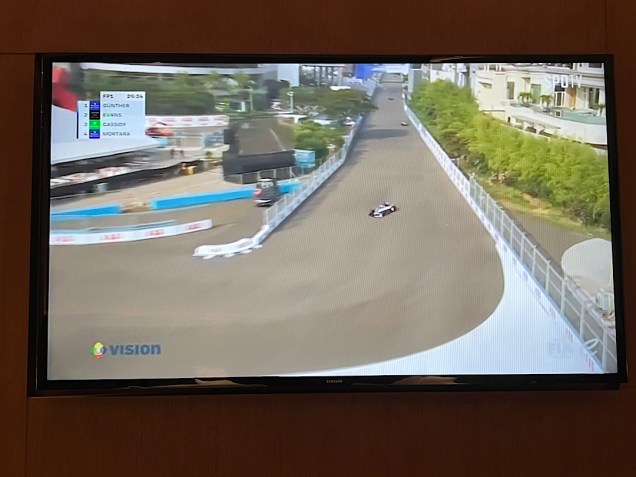 It looked like the race would take place at some course near the sea.
It looked like the race would take place at some course near the sea.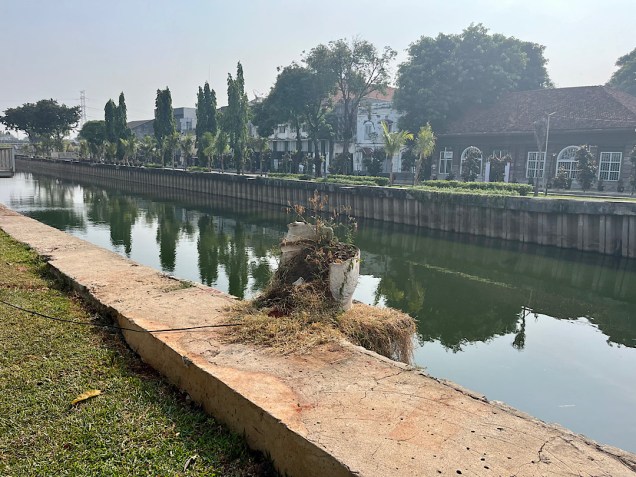
 The town hall was built in 1627.
The town hall was built in 1627.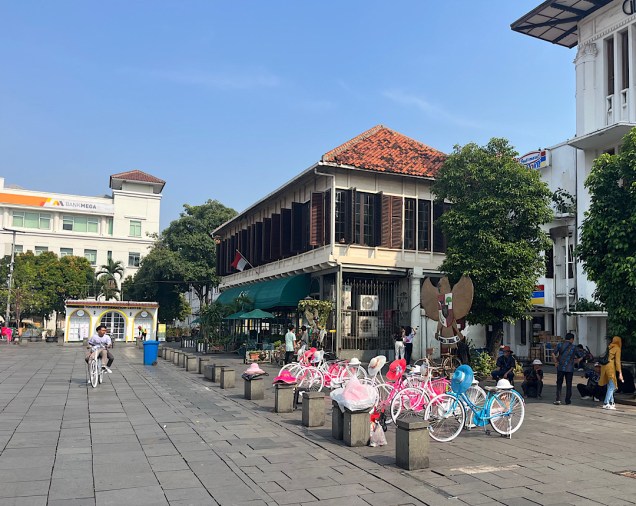 That building with the red tile roof now houses the Cafe Batavia, where we ate dinner.
That building with the red tile roof now houses the Cafe Batavia, where we ate dinner. In a different latitude we might have hiked the 2-3 miles from there to central Jakarta, but the heat and humidity made that unthinkable.
In a different latitude we might have hiked the 2-3 miles from there to central Jakarta, but the heat and humidity made that unthinkable.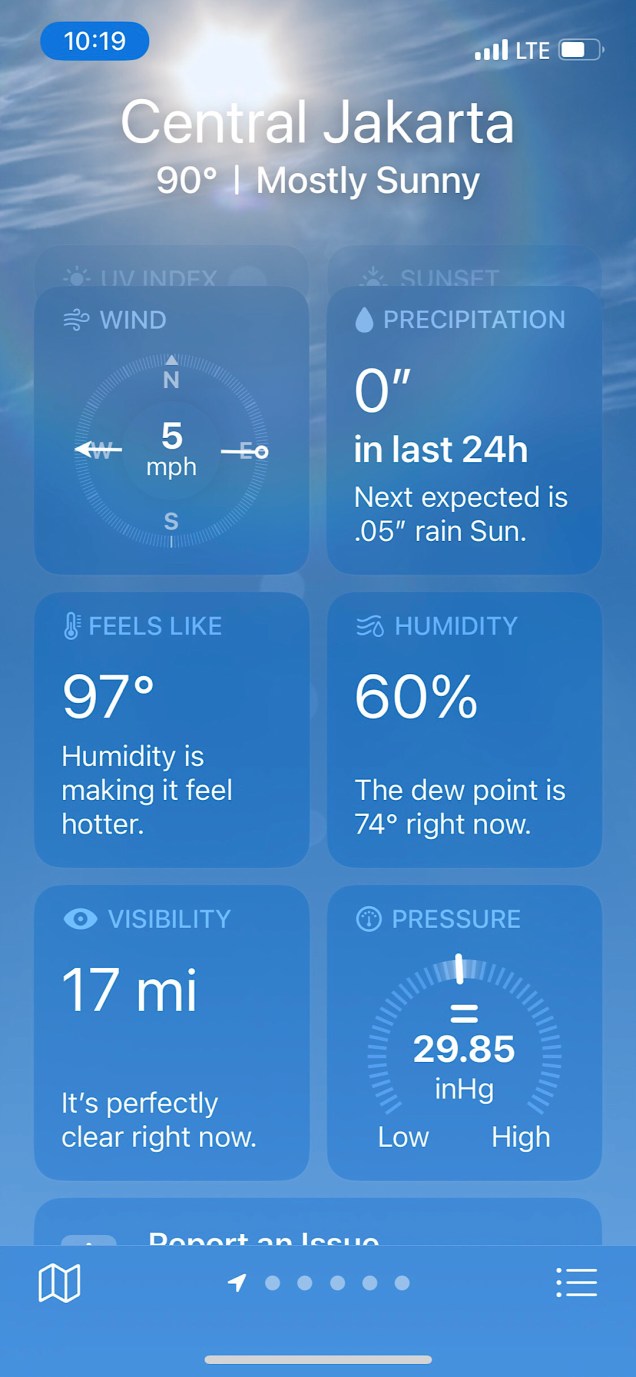 Instead we enjoyed a tuk-tuk ride that gave us insight into Jakarta’s infamous traffic.
Instead we enjoyed a tuk-tuk ride that gave us insight into Jakarta’s infamous traffic.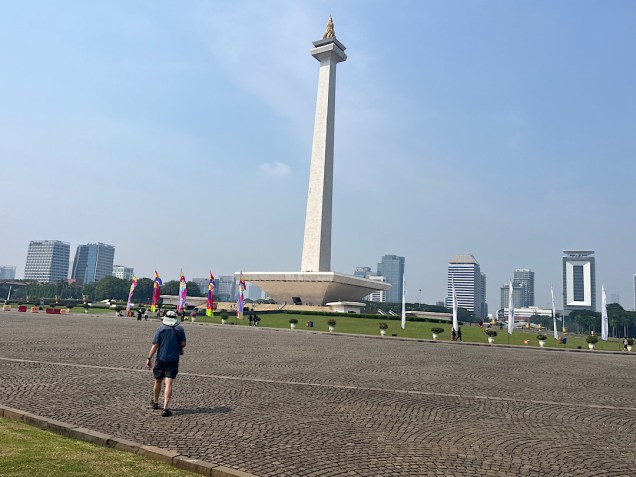 We abandoned our plans to climb to top when we learned it would probably take three hours to get up there, the line of locals already was that long.
We abandoned our plans to climb to top when we learned it would probably take three hours to get up there, the line of locals already was that long. The nearby national museum was less crowded. We could have spent hours, had we more time and energy but instead mostly marveled at the galleries focusing on Indonesia’s paleoanthropology. Somehow homonids who walked upright made their way from Africa to these islands a million and a half years ago. How did that happen?
The nearby national museum was less crowded. We could have spent hours, had we more time and energy but instead mostly marveled at the galleries focusing on Indonesia’s paleoanthropology. Somehow homonids who walked upright made their way from Africa to these islands a million and a half years ago. How did that happen? It was a bit before 7 pm, and people were wandering into the square and plopping down on the stones. You could feel all the energy pulsing through the place, Steve insisted. And it emanated from some of the sweetest people we’ve met anywhere.
It was a bit before 7 pm, and people were wandering into the square and plopping down on the stones. You could feel all the energy pulsing through the place, Steve insisted. And it emanated from some of the sweetest people we’ve met anywhere. Still it all looked extraordinarily convivial. Little kids tossed lighted twirling things into the air or blew bubbles. Their parents snacked on chips and drank soda. I saw a few folks getting their pictures taken with the living statues.
Still it all looked extraordinarily convivial. Little kids tossed lighted twirling things into the air or blew bubbles. Their parents snacked on chips and drank soda. I saw a few folks getting their pictures taken with the living statues.
 I also saw a bunch of the wannabe photo props bored by the lack of business.
I also saw a bunch of the wannabe photo props bored by the lack of business. PS: I shot this from my window seat on the plane going into Jakarta as we were flying somewhere over Borneo. But it’s the closest we got to any big geological events. We didn’t feel so much as a small jolt. That was fine with me too.
PS: I shot this from my window seat on the plane going into Jakarta as we were flying somewhere over Borneo. But it’s the closest we got to any big geological events. We didn’t feel so much as a small jolt. That was fine with me too. The news was discouraging when we landed on Rinca Island Tuesday afternoon. No one had spotted any Komodo dragons that entire day — nor the day before. I tried to resign myself to the same fate. When you seek rare animals in the wild, it’s not like buying a movie ticket. You’re not guaranteed a show. But we lucked out.
The news was discouraging when we landed on Rinca Island Tuesday afternoon. No one had spotted any Komodo dragons that entire day — nor the day before. I tried to resign myself to the same fate. When you seek rare animals in the wild, it’s not like buying a movie ticket. You’re not guaranteed a show. But we lucked out.

 Another score! The ranger asked for Steve’s phone and recorded the temporary occupant: a male whose big belly testified to recent consumption of a meaty feast. Now he was digesting in the cool comfort of the man-made shelter.
Another score! The ranger asked for Steve’s phone and recorded the temporary occupant: a male whose big belly testified to recent consumption of a meaty feast. Now he was digesting in the cool comfort of the man-made shelter.








 This was breakfast the second morning.
This was breakfast the second morning. The view from near the top, taking in three different-colored beaches (black, white, and pink) is so famous it’s on Indonesia’s 50,000-rupiah bank note. Indonesian tour groups pressed for time will often choose to visit it and skip the Komodo dragons, according to Robert.
The view from near the top, taking in three different-colored beaches (black, white, and pink) is so famous it’s on Indonesia’s 50,000-rupiah bank note. Indonesian tour groups pressed for time will often choose to visit it and skip the Komodo dragons, according to Robert.
 This time our park ranger, Dula, took my iPhone and shot the wonderful video footage I will try to incorporate here. I hope it’s viewable on the blog; part terrifying, part comic, it’s documentary evidence of one of the most unforgettable strolls of my life.
This time our park ranger, Dula, took my iPhone and shot the wonderful video footage I will try to incorporate here. I hope it’s viewable on the blog; part terrifying, part comic, it’s documentary evidence of one of the most unforgettable strolls of my life. We didn’t succeed at seeing all of it. The wind blew hard for a few hours on our final morning, whipping up white caps that drove the local manta rays and sea turtles to deeper water. But we did manage to snorkel three times in calm water, and each outing delighted me. The sea was clear and warm, and I felt as close as I will ever get to flight, gliding effortlessly over the landscape of coral and anemones and rocks, in the company of neon-colored fish, many dressed up in astonishing patterns. At times we sailed by rivers of fish; into clouds of them. Once I started to laugh out loud at the concentrated beauty but was quickly reminded that’s not a great idea when you’re breathing through a snorkel.
We didn’t succeed at seeing all of it. The wind blew hard for a few hours on our final morning, whipping up white caps that drove the local manta rays and sea turtles to deeper water. But we did manage to snorkel three times in calm water, and each outing delighted me. The sea was clear and warm, and I felt as close as I will ever get to flight, gliding effortlessly over the landscape of coral and anemones and rocks, in the company of neon-colored fish, many dressed up in astonishing patterns. At times we sailed by rivers of fish; into clouds of them. Once I started to laugh out loud at the concentrated beauty but was quickly reminded that’s not a great idea when you’re breathing through a snorkel. We watched the molten tangerine sliver of sun shrink to a dot and disappear and the color begins to drain from the sky. Several long moments passed, but enough of a glow still remained that I could make out the strange thing that began to occur — a stream of tiny black objects rising out of the mangroves like cinders flowing up from a campfire and dispersing.
We watched the molten tangerine sliver of sun shrink to a dot and disappear and the color begins to drain from the sky. Several long moments passed, but enough of a glow still remained that I could make out the strange thing that began to occur — a stream of tiny black objects rising out of the mangroves like cinders flowing up from a campfire and dispersing. The stream thickened and grew; that’s when I cried out. These were fruit bats, a vast horde of them, ranging out by the millions to hunt insects in the night.
The stream thickened and grew; that’s when I cried out. These were fruit bats, a vast horde of them, ranging out by the millions to hunt insects in the night.

